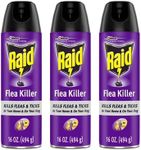Buying Guide for the Best Flea Treatment For Carpets
Choosing the right flea treatment for your carpets is crucial to ensure a flea-free home and a healthy environment for you and your pets. Fleas can be persistent and challenging to eliminate, so it's important to select a product that is effective and safe. Here are some key specifications to consider when picking a flea treatment for carpets, along with explanations to help you make an informed decision.Active IngredientsActive ingredients are the chemicals in the flea treatment that kill or repel fleas. This spec is important because different ingredients target fleas in various ways, and some may be more effective than others. Common active ingredients include pyrethrins, permethrin, and methoprene. Pyrethrins are natural insecticides derived from chrysanthemum flowers and are generally safe but may require frequent application. Permethrin is a synthetic version of pyrethrins and tends to be more potent and longer-lasting. Methoprene is an insect growth regulator that prevents flea larvae from developing into adults. Choose an active ingredient based on the severity of your flea problem and any sensitivities your pets or family members may have.
Formulation TypeFlea treatments for carpets come in various formulations, such as powders, sprays, and foggers. This spec is important because the formulation affects how you apply the treatment and its effectiveness. Powders are easy to apply and can be vacuumed up after a certain period, making them suitable for regular maintenance. Sprays allow for targeted application and can be used on specific areas where fleas are concentrated. Foggers, or flea bombs, release a fine mist that covers a large area and is ideal for severe infestations. Choose a formulation based on the extent of the infestation and your preference for application.
Residual EffectThe residual effect refers to how long the flea treatment remains effective after application. This spec is important because it determines how often you need to reapply the treatment to keep fleas at bay. Treatments with a longer residual effect can provide ongoing protection and reduce the need for frequent reapplication. Residual effects can range from a few days to several months. If you have a severe infestation, a treatment with a longer residual effect may be more beneficial. For regular maintenance, a shorter residual effect may suffice.
Safety for Pets and HumansSafety is a critical spec to consider, especially if you have pets or small children. Some flea treatments contain chemicals that can be harmful if ingested or inhaled. Look for products that are labeled as safe for use around pets and humans. Natural or organic treatments may be a safer option, though they may require more frequent application. Always follow the manufacturer's instructions and take precautions, such as keeping pets and children away from treated areas until the product has dried or settled.
Ease of UseEase of use refers to how simple and convenient the flea treatment is to apply. This spec is important because a product that is difficult to use may lead to improper application and reduced effectiveness. Consider factors such as the application method, drying time, and any additional steps required (e.g., vacuuming). Choose a product that fits your lifestyle and comfort level with application procedures. If you prefer a quick and straightforward process, opt for treatments that require minimal effort and time.
Coverage AreaCoverage area indicates how much surface area the flea treatment can cover. This spec is important because it helps you determine how much product you need to treat your entire carpeted area. Coverage area is usually measured in square feet or square meters. For larger spaces, you may need a product with a higher coverage capacity or multiple units. Assess the size of the area you need to treat and choose a product that can adequately cover it without requiring excessive amounts.





















